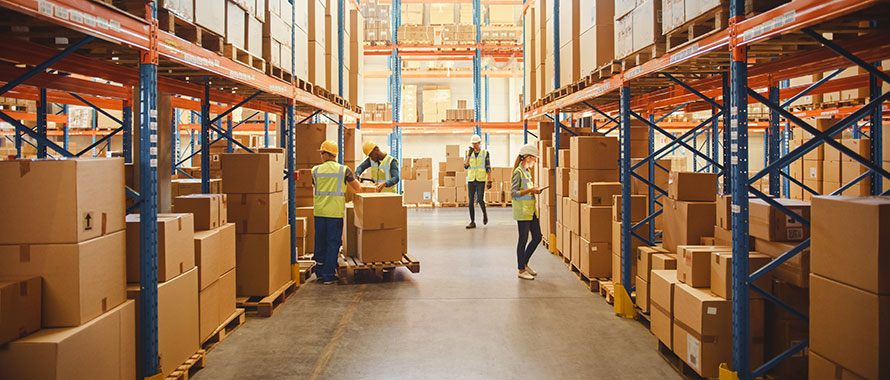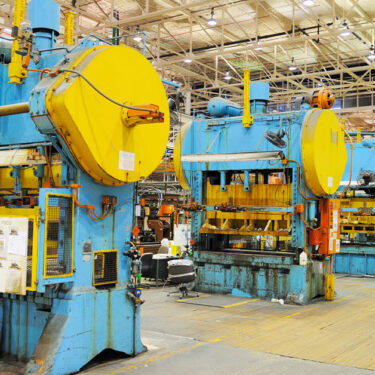A massive fire at a QVC warehouse in Rocky Mount, North Carolina, on Dec. 19 destroyed 75% of the 1.5 million-square-foot facility and killed one worker, according to news reports. The five-alarm blaze rendered the site inoperable and has reportedly prompted the company, a major employer in the area, to plan to lay off all of its more than 1,900 employees at the location starting Feb. 1. Long-term plans for the site have not been determined, and the cause of the fire is still under investigation.
Just days earlier on Dec. 12, an Amazon warehouse in Edwardsville, Illinois, partially collapsed when an EF-3 tornado struck the 1.1 million-square-foot building, killing six employees. The tragedy raised questions over Amazon’s workplace safety procedures after reports emerged that workers may have had inadequate shelter or training for severe weather events.

These types of events are exactly why companies have insurance. It is a catastrophic event; one is a fire, one is from nature. There is not a lot you can do to prevent many of these.
Both incidents represent the type of natural disaster that can threaten life and property at large warehouses, which are in increasing demand. For these facilities, Commercial Property Insurance, Stock Throughput Insurance, Commercial General Liability (CGL) Insurance and other policies are of utmost importance.
“These types of events are exactly why companies have insurance,” said Barry Whitton, Managing Director, Broker, Property, Burns & Wilcox Brokerage, Atlanta, Georgia. “It is a catastrophic event; one is a fire, one is from nature. There is not a lot you can do to prevent many of these. That is why you need insurance.”
Warehouses face multiple perils, particularly as severe weather events increase
Fires and severe weather events are among the top property risks facing warehouses, said Leena Malik, Senior Underwriter, Commercial Insurance, Burns & Wilcox, Toronto, Ontario. Other recent incidents include a winter storm Jan. 3 in Mooresville, North Carolina, where strong winds caused a warehouse building to collapse, according to the Queen City News, and a Jan. 6 fire that destroyed two 1800s-era warehouses in Superior, Wisconsin, WDIO News reported.
“The number one peril for any sort of storage or warehousing facility would be fire,” Malik said. “When you have goods tightly packed together, some of them may be combustible, and the damage from fire can be quite extensive. Even a small flame can result in quite a devastating loss.”
Commercial Property Insurance can cover losses related to natural disasters, fire, wind, collapse, hail, explosion and other perils. Covered expenses may include physical property repairs, business contents, damaged goods and, in some cases, loss of income. CGL Insurance would be needed to cover expenses related to third-party injuries or property damage, and Workers’ Compensation Insurance could respond to worker injuries.
Even warehouses built to the highest standards cannot usually withstand the impact of a severe weather event, said Brendan Cook, Vice President & Managing Director, Global Excess Partners, New York, New York.
“There are very few buildings that are actually constructed to be able to take a direct hit from an EF-3 or worse tornado because the wind speeds are just so severe,” he said. “The cost to build structures to withstand those storms is quite significant and tornadoes can be relatively random. The lead time associated with tornadoes is minutes, not hours or days like you would have with a hurricane, which creates more difficulty.”
Most warehouses “are built very well” and could be safer than other structures during a storm, Whitton said, adding that weather risks tend to be unavoidable since warehouses are often located where they are most geographically needed. “They put them as close as they can to their distribution networks, so there may not be a way around that.”
Stock Throughput Insurance could also help protect warehouse owners from losses, Cook added. “That could cover an item from the moment it is manufactured, through transit from the manufacturing location to the intermediate distribution channel, and ultimately to the final purchaser, whether that shipment is by ocean or by rail,” he explained.

Whether they own a billion-dollar warehouse or a small business, property owners need to be aware of the exposures that are around us now as the environment is changing and respond accordingly.
The National Oceanic and Atmospheric Administration recently estimated that extreme weather events in the U.S. cost $145 billion in 2021, making it the third-costliest year to date for severe weather, according to a Jan. 11 NPR report. With climate change expected to continue increasing the frequency and severity of extreme weather, it is a risk that property owners should keep in mind, Cook said.
“Natural catastrophes are increasing and that is obvious from what we are seeing around the world and around the country,” he said. “Just because you have not been in a catastrophic zone does not mean that you will not be in one tomorrow. Whether they own a billion-dollar warehouse or a small business, property owners need to be aware of the exposures that are around us now, as the environment is changing, and respond accordingly.”
Alongside natural disasters like wildfire and tornados, manmade perils like theft are another concern, Malik said. Thefts, whether perpetrated by warehouse visitors or employees, could also be covered by Commercial Property Insurance.
“When you have warehouses storing hundreds of thousands of dollars of goods, you always have that risk, especially if there is not proper record-keeping of who is entering which storage unit and which particular time,” she said. “That is something policy holders need to review with their broker, to ensure they have correct coverage in place.”
Be aware of aggregate values in large warehouses
Major retailers are increasingly opting to own their own warehouses, the Wall Street Journal reported in October 2021, with 2020 figures showing that the U.S.’s 25 largest retailers acquired about 38 million rentable square feet in new industrial space that year versus 18.8 million square feet in 2019. In Burnaby, British Columbia, a 65-acre business park is currently being developed that will offer a combined total floor area of 1.3 million square feet and will be occupied in part by Amazon, which will use over 500,000 square feet, Daily Hive reported.
Smaller warehouses can also suffer significant losses. In March 2021, a warehouse fire in Waikapu, Maui, caused an estimated $1 million in damage, including $466,000 in damage to the 2,240-square-foot facility and $500,000 in lost contents, the Honolulu Star-Advertiser reported.
“Demand for private storage facilities is also increasing as well. When you have a number of these facilities, they need land, so they are going out into the more rural areas and sometimes all congregating in these spaces, which is a significant risk,” Malik said. “When you have two or three warehouses on the same street, all of those risks are subject to one another. If a flame ignites in one warehouse, the fire can spread to a neighboring property.”
In exceptionally large warehouses like the Amazon and QVC facilities, Cook said, the “pure aggregation of values of a single site” is a major consideration for Commercial Property Insurance purposes.
“These warehouses are huge; a million-plus square feet,” Cook said, pointing to conveyor belt systems, automation equipment for stock-picking and other expensive machinery on-site, in addition to major quantities of goods. “The concentration of values is quite large. These are big operations with big values.”
Distribution networks have become even more robust over the past two to three years, Whitton added, making larger, single warehouses using distribution hub networks more common.
“The insurance has to cover all the values of that warehouse,” Whitton said.
After a loss occurs, a warehouse owner may need to begin storing products elsewhere during rebuilding, which is another cost that could be covered by Commercial Property Insurance. “There will be some additional transportation costs for the goods, and they may have to truck in items or get smaller warehouses for local distribution,” he said. “There should be risk management and business continuity plans in place to help offset some of that.”
When the cost or time required to rebuild a warehouse on the same site is too much, a warehouse owner may choose to permanently shut down the site, as in the recent QVC incident, Whitton said.
“If that was not a profitable warehouse for them, when insurance products pay out, they do not have to necessarily pay out at that site. They could use those insurance proceeds to offset the cost of another warehouse they are already building,” he said. “There may be a better place to build that warehouse, logistically, for them.”
That can be devastating for a community, Cook added. “The employees could have lost their home from the same event, and now they are losing their job. The social impact on a region can be pretty severe,” he said.
Consider business interruption, consult with experts
When a warehouse is inoperable due to weather damage or another covered event, Commercial Property Insurance may be able to help with the loss of revenue while repairs are made.
“The coverage is usually for actual loss sustained,” Whitton explained. “The goods can either be covered on a selling-price evaluation, meaning the cost of the product plus the cost of the profit margin; or it could be pure replacement cost. It just depends on the way the contract is put together.”
Lost revenue can be exacerbated when a loss occurs at a particularly challenging time, such as the holiday rush. Although a company like Amazon would likely have backup processes in place to avert major losses, there could still be unexpected costs like shipping items to a different location. “When Christmas is coming, the date does not change because a warehouse was damaged. A company can run the risk of losing customers from this type of event,” he said. “Smaller business owners are often the ones that really struggle because the sudden costs can be huge.”
In certain industries, such as fashion, a warehouse loss and the subsequent delays could mean missing industry trends. “The loss of customers and the delay of service to customers is something they may not have insurance coverage for, so that is a business risk,” Cook said.
Warehouse owners may also want to ask their insurance broker about Inland Marine Insurance, Flood Insurance and other policies that could potentially help protect them.
“When there are more minds involved, you can make better decisions,” Cook said. “The business proprietor knows his business backwards because he does it all day every day. He does not necessarily know the state of the insurance market and the coverages available, nor the best price or the right carrier to choose. Getting a professional involved gives you a much better chance of making a better decision for your insurance needs.”
Risk management procedures should also be reviewed regularly, Malik added. This should include employee safety and emergency preparedness training, regular warehouse inspections, monitored alarms, and sprinkler systems.
If the cost of insuring a warehouse is a concern, “speak to your insurance broker,” Malik recommended. “That is where their expertise plays in and they can provide you with different options. Find someone who is specialized in warehousing and who can link you to the correct market.”







